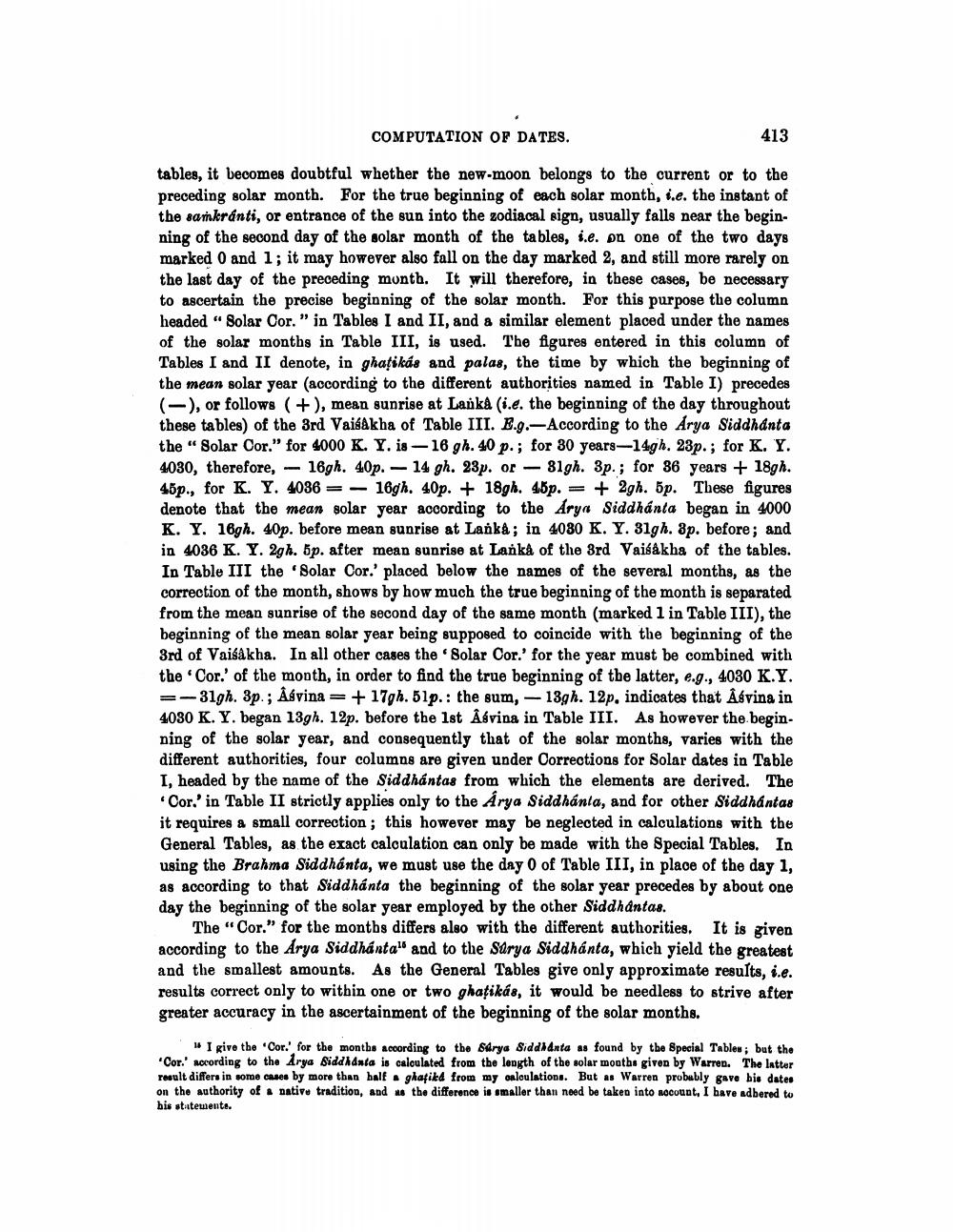________________
COMPUTATION OF DATES.
413
tables, it becomes doubtful whether the new-moon belongs to the current or to the preceding solar month. For the true beginning of each solar month, i.e. the instant of the sankranti, or entrance of the sun into the zodiacal sign, usually falls near the begin. ning of the second day of the solar month of the tables, i.e. on one of the two days marked 0 and 1; it may however also fall on the day marked 2, and still more rarely on the last day of the preceding month. It will therefore, in these cases, be necessary to ascertain the precise beginning of the solar month. For this purpose the column headed " Solar Cor." in Tables I and II, and a similar element placed under the names of the solar months in Table III, is used. The figures entered in this column of Tables I and II denote, in ghatikás and palas, the time by which the beginning of the mean solar year (according to the different authorities named in Table I) precedes (-), or follows (+), mean sunrise at Lanka (i.e. the beginning of the day throughout these tables) of the 3rd Vaisakha of Table III. E.g.--According to the Arya Siddhanta the "Solar Cor." for 4000 K. Y. is — 16 gh. 40 p.; for 30 years---14gh. 23p.; for K. Y. 4030, therefore, - 16gh. 40p. - 14 gh. 23p. or - 819h. 3p.; for 86 years + 18gh. 45p., for K. Y. 4036 = - 160h. 40p. + 18gh. 45p. = + 2gh. 5p. These figures denote that the mean solar year according to the Arya Siddhanta began in 4000 K. Y. 169h. 40p. before mean sunrise at Lanka; in 4030 K. Y. 319h. 3p. before; and in 4036 K. Y. 2gh. 5p. after mean sunrise at Lanka of the 3rd Vaisakha of the tables. In Table III the 'Solar Cor.' placed below the names of the several months, as the correction of the month, shows by how much the true beginning of the month is separated from the mean sunrise of the second day of the same month (marked 1 in Table III), the beginning of the mean solar year being supposed to coincide with the beginning of the 3rd of Vaisakha. In all other cases the Solar Cor.' for the year must be combined with the.Cor.' of the month, in order to find the true beginning of the latter, e.g., 4030 K.Y. =-319h. 3p.: Asvina = + 17gh. 51p.: the sum, - 13gh. 12p, indicates that Asvina in 4030 K. Y. began 13gh. 12p. before the 1st Âbvina in Table III. As however the begin. ning of the solar year, and consequently that of the solar months, varies with the different authorities, four columns are given under Corrections for Solar dates in Table 1, headed by the name of the Siddhantas from which the elements are derived. The
Cor.' in Table II strictly applies only to the Arya Siddhanta, and for other Siddhantas it requires a small correction; this however may be neglected in calculations with the General Tables, as the exact calculation can only be made with the Special Tables. In using the Brahma Siddhanta, we must use the day 0 of Table III, in place of the day 1, as according to that Siddhanta the beginning of the solar year precedes by about one day the beginning of the solar year employed by the other Siddhantas.
The "Cor." for the months differs also with the different authorities. It is given according to the Arya Siddhanta' and to the Surya Siddhanta, which yield the greatest and the smallest amounts. As the General Tables give only approximate results, i.e. results correct only to within one or two ghatikás, it would be needless to strive after greater accuracy in the ascertainment of the beginning of the solar months.
# I give the "Cor. for the months according to the Sarya Siddhanta as found by the Special Tables; but the "Cor.' according to the Arya Siddhanta is calculated from the length of the solar months given by Warren. The latter result differs in some cases by more than half ghafikd from my aaloulations. But as Warren probably gave bis dates on the authority of a native tradition, and as the difference is smaller than need be taken into nocount, I have adbered to bis statemente.




